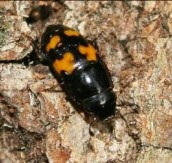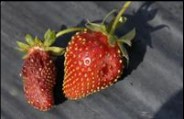Picnic/sap beetles
Picnic beetles, also called sap beetles, are a complex of over 180 species of beetles that feed on damaged, overripe, or decomposing fruits and vegetables. Most of them are small ( 1 8 ⁄ ” to ¼” long) and oval. An important identifying characteristic for sap beetles is the clubbed antennae (knob at the end of the antennae) on the adult beetles. The eggs are small, ~1/25” long, milky white, and are laid within plant matter. Larvae are less than ¼” long, white (turning pale yellow when mature) with a light brown head.
| Common Name | Picnic beetles, also called sap beetles |
| Order | Coleoptera |
| Family | Nitidulidae |
| Scientific Name | Glischrochilus spp. and Stelidota spp. |
Life Cycle: Sap beetles overwinter as adults in plant cover near the soil. They emerge in the spring, feed on fungi, pollen, sap or decaying matter, and lay eggs. Larvae feed for about three weeks and emerge as adults in mid-summer. Adults fly into fruit and vegetable plantings from wooded areas at about the time berries begin to ripen. Strawberry sap beetle (Stelidota geminata) overwintering adults fly into strawberries planting from wooded areas, feed on berries, sometimes in groups, and females lay eggs on the injured fruit. In general, there is only one generation per year for sap beetles.

Damage: Sap beetles chew deep cavities in ripe berries and this injury may lead to colonization by pathogens. Sap beetles can directly damage fruits and vegetables. Overripe fruit is very attractive to sap beetles, and often they can be found on previously damaged or diseased fruits. The feeding by sap beetles makes fruit unmarketable and the beetles themselves can contaminate harvested fruits. Pick your own operations may suffer greater damage where pickers leave large numbers of ripe and over-ripe fruit in the field. Late maturing varieties of raspberry are more vulnerable as populations of sap beetles continue to increase throughout the summer.

Cultural control: Practicing sanitation by removing overripe, damaged, and diseased berries from a planting and frequent and complete picking will decrease the attractiveness of the planting. Culled fruit can be buried deep in the soil or destroyed to eliminate attractant chemicals and reduce food sources for picnic beetles.
Mechanical control: Trapping with buckets baited with over-ripe fruit can be effective at reducing beetle populations. Place traps outside field borders, especially near woodland edges, as the crop begins to ripen to intercept adults moving into the planting from outside areas. Other baits include stale beer, vinegar, and molasses-yeast-water mixture. Trapped beetles should be discarded often (every 3-4 days) and traps rebaited.
Chemical control: If the use of an insecticide is warranted, ensure penetration of the canopy and be aware of preharvest intervals as these insects are present when fruit is ripening and ripe. Insecticides recommended for controlling strawberry sap beetles include Assail, Brigade, Danitol, and Rimon. All product recommendations can be found in the latest Midwest Fruit Pest Management Guide. Additionally, you should always fully read and follow the label before spraying any pesticide.
This article was posted in Insects and tagged picnic beetles, Sap Beetles.
